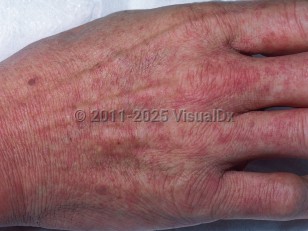Mononucleosis in Adult
Alerts and Notices
Important News & Links
Synopsis

Infectious mononucleosis is caused by Epstein-Barr virus (EBV), a member of the human herpesvirus family. A prodromal period of 3-5 days includes headache, malaise, myalgia, and fatigue. In adults, fever to 39°C (102.2°F) may persist for 7-10 days or longer in severe cases, with 80%-95% of people reporting some fever.
The classic clinical triad consists of fever, pharyngitis, and cervical adenopathy. Malaise, sweats, sore throat, anorexia, nausea, and headache are the most common symptoms. Myalgias, ocular muscle pain, chest pain, and rhinitis are not infrequent. Photophobia and arthralgias may also occur. The patient appears generally ill with readily apparent cervical adenopathy in most cases. Splenomegaly typically occurs during the second and third week. Hepatomegaly rarely develops.
The classic mononucleosis syndrome occurs almost without exception in teenagers and young adults.
Patients treated with ampicillin or penicillins often develop an exanthematous rash one week following initiation of therapy.
Splenic rupture, which is rare, may be fatal. Other rare complications include upper airway obstruction, hemolytic anemia, thrombocytopenic purpura, severe granulocytopenia, pneumonia, meningoencephalitis, recurrent aseptic meningitis (Mollaret's meningitis), Guillain-Barré syndrome, Miller Fisher syndrome (bilateral ptosis, total ophthalmoplegia, cerebellar symptoms and hyporeflexia), psychosis, Bell palsy, myocarditis, pericarditis, coronary artery spasm, pancreatitis, nephritis, and fulminating hepatic necrosis. Neurological complications, airway obstruction, and splenic rupture are the most common causes of death in otherwise healthy persons. Gastrointestinal symptoms, palatal petechiae, and insidious onset are associated with a prolonged recovery period. Occasionally, jaundice, arthritis, and pneumonitis are seen.
The classic clinical triad consists of fever, pharyngitis, and cervical adenopathy. Malaise, sweats, sore throat, anorexia, nausea, and headache are the most common symptoms. Myalgias, ocular muscle pain, chest pain, and rhinitis are not infrequent. Photophobia and arthralgias may also occur. The patient appears generally ill with readily apparent cervical adenopathy in most cases. Splenomegaly typically occurs during the second and third week. Hepatomegaly rarely develops.
The classic mononucleosis syndrome occurs almost without exception in teenagers and young adults.
Patients treated with ampicillin or penicillins often develop an exanthematous rash one week following initiation of therapy.
Splenic rupture, which is rare, may be fatal. Other rare complications include upper airway obstruction, hemolytic anemia, thrombocytopenic purpura, severe granulocytopenia, pneumonia, meningoencephalitis, recurrent aseptic meningitis (Mollaret's meningitis), Guillain-Barré syndrome, Miller Fisher syndrome (bilateral ptosis, total ophthalmoplegia, cerebellar symptoms and hyporeflexia), psychosis, Bell palsy, myocarditis, pericarditis, coronary artery spasm, pancreatitis, nephritis, and fulminating hepatic necrosis. Neurological complications, airway obstruction, and splenic rupture are the most common causes of death in otherwise healthy persons. Gastrointestinal symptoms, palatal petechiae, and insidious onset are associated with a prolonged recovery period. Occasionally, jaundice, arthritis, and pneumonitis are seen.
Codes
ICD10CM:
B27.90 – Infectious mononucleosis, unspecified without complication
SNOMEDCT:
271558008 – Infectious mononucleosis
B27.90 – Infectious mononucleosis, unspecified without complication
SNOMEDCT:
271558008 – Infectious mononucleosis
Look For
Subscription Required
Diagnostic Pearls
Subscription Required
Differential Diagnosis & Pitfalls

To perform a comparison, select diagnoses from the classic differential
Subscription Required
Best Tests
Subscription Required
Management Pearls
Subscription Required
Therapy
Subscription Required
References
Subscription Required
Last Updated:09/21/2021
 Patient Information for Mononucleosis in Adult
Patient Information for Mononucleosis in Adult
Premium Feature
VisualDx Patient Handouts
Available in the Elite package
- Improve treatment compliance
- Reduce after-hours questions
- Increase patient engagement and satisfaction
- Written in clear, easy-to-understand language. No confusing jargon.
- Available in English and Spanish
- Print out or email directly to your patient
Upgrade Today

Mononucleosis in Adult

